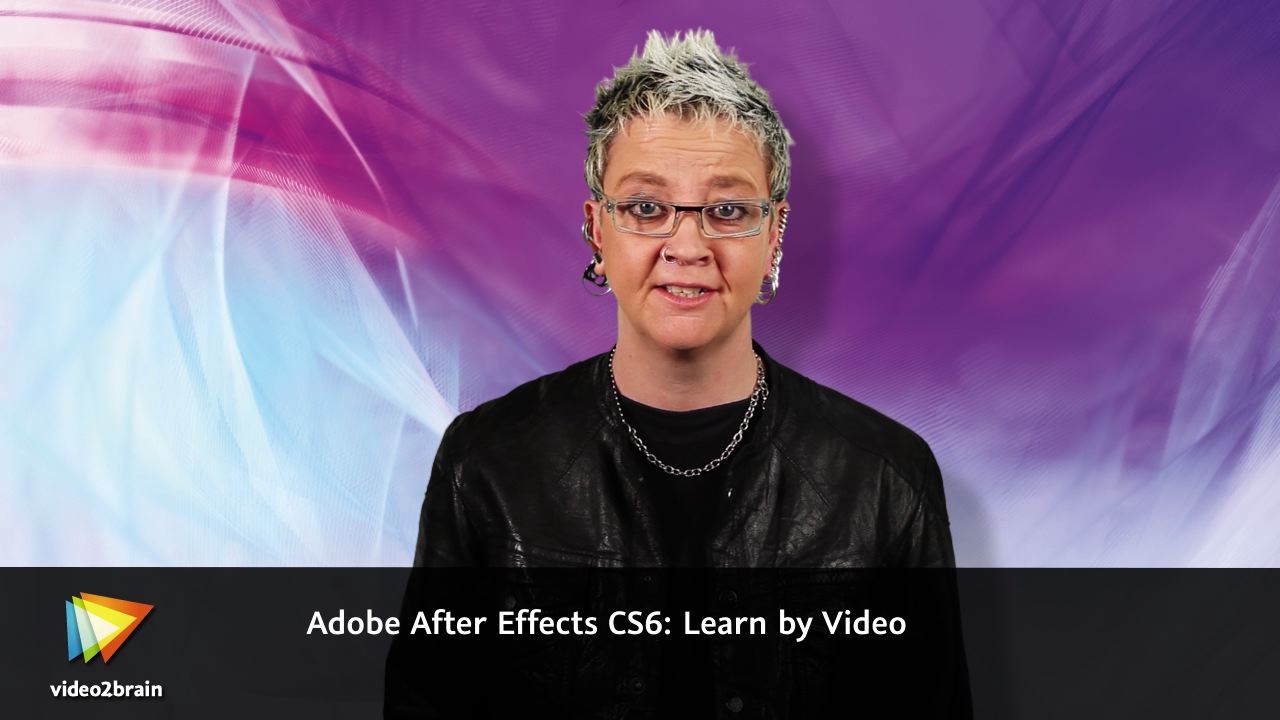Publishers of technology books, eBooks, and videos for creative people
Adobe After Effects CS6: Learn by Video
- By Angie Taylor, Todd Kopriva, video2brain
- Published Jul 27, 2012 by Peachpit Press. Part of the Learn by Video series.

DVD
- Sorry, this book is no longer in print.
Register your product to gain access to bonus material or receive a coupon.
Description
- Copyright 2013
- Dimensions: Special (all other)
- Pages: 48
- Edition: 1st
- DVD
- ISBN-10: 0-321-84038-0
- ISBN-13: 978-0-321-84038-7
This innovative product from Adobe Press and video2brain combines interactive video and a full--color printed reference to teach the fundamentals of Adobe After Effects CS6. Experienced instructors Todd Kopriva and Angie Taylor present 10 hours of high quality HD video, complete with lesson files, assessment quizzes and review materials. The video is wrapped in a unique interface that allows the viewer to jump to any topic and also bookmark individual sections for later review. The unique Watch--and--Work mode shrinks the video into a small window to allow the student to work alongside in After Affects. Project files used in the lessons are included on the disc so viewers can practice what they’ve learned, and interactive review questions help reinforce freshly gained knowledge. The DVD-ROM is bundled with a printed brook that provides supplemental material to enhance the video training.
This course will not only show you the basics of After Effects, it also teaches you what you'll need to know to take your skills to the next level. The presenters will give you an overview of the workflow and the user interface, and then you will learn how to bring assets into After Effects. They'll explain how to configure After Effects for optimum performance, focusing on the global performance cache and persistent disk cache features added in After Effects CS6. You’ll learn a range of compositing features, including the new variable-width masks and 3D camera tracker features introduced in After Effects CS6, as well as basic masking and color keying. You will discover how to troubleshoot and avoid common problems, and then how to create finished movie files.
Sample Content
Table of Contents
1 Introducing After Effects CS6
1.1 What Is Adobe After Effects and Where Does It Come From?
1.2 Course Introduction
1.3 What’s New in After Effects CS6
1.4 Don’t Worry, It’s Only a Dialog Box
1.5 Basic Workflow and Terminology Overview
2 Interface Tour
2.1 The Project Panel and Flowchart Panel
2.2 The Composition Panel and the Layer Panel
2.3 The Timeline Panel
2.4 The Preview Panel
2.5 The Effects & Presets Panel, Bridge, and the Effect Controls Panel
2.6 Colors, Channels, and Color Bit Depth
2.7 Modifying Preferences and Keyboard Shortcuts
2.8 Configuring the User Interface
3 Creating Compositions and Layers
3.1 Creating Compositions and Changing Composition Settings
3.2 Creating Text with the Character Panel
3.3 Controlling Blocks of Text with the Paragraph Panel
3.4 Creating Shape Layers 3.5 Working with Solids
4 Importing Footage
4.1 Importing Movies
4.2 Importing Still Images and Image Sequences
4.3 Importing Photoshop and Illustrator Files
4.4 Importing Projects
5 Interpreting and Managing Footage
5.1 Interpreting Footage Manually and Automatically
5.2 Fields and Interlacing
5.3 Pixel Aspect Ratios
5.4 Trimming Footage and Layers
6 Animation Basics
6.1 Animating Transform Properties
6.2 Working with Motion Paths
6.3 Using Motion Sketch to Record Motion
7 Fine-Tuning Animation
7.1 Working in the Layer Panel
7.2 Anchor Point Animation
7.3 Keyframe Types
7.4 Keyframe Assistants
7.5 The Graph Editor
8 Animating Text Layers
8.1 Importing Photoshop Text
8.2 Applying Animators
8.3 Combining Animators
8.4 Animation Presets
9 Fun with Shape Layers
9.1 Ways to Create Shapes
9.2 Shape Layers for Text Effects
10 Basic Compositing
10.1 Blending Layers with Blending Modes
10.2 Alpha Channels and Transparency
10.3 Isolating a Subject with a Mask
10.4 Color Keying
10.5 Motion Tracking and Rotoscoping
10.6 The 3D Camera Tracker
11 Effects
11.1 Understanding Effect Categories
11.2 Animating Effect Properties
11.3 Brainstorming
11.4 Using Compound Effects
11.5 “Fixer” Effects
11.6 Layer Styles
11.7 Effect Presets
11.8 Adjustment Layers (Force Motion Blur)
12 Time
12.1 Frame Rates
12.2 Time Stretching and Time Remapping
12.3 Slowing Motion, Freezing a Frame, and Reversing Time
13 Grouping and Linking
13.1 Nesting
13.2 Pre-Composing
13.3 Parenting
13.4 Using Nulls
13.5 Expressions
14 introduction to 3d
14.1 Working with 3D Layers
14.2 Axis Modes
14.3 Bending Layers
14.4 Extruding Shapes
14.5 Cameras
14.6 Lights
14.7 Material Options(Environment Layers)
14.8 Depth of Field
14.9 Environment Layers
15 Memory and Performance
15.1 Setting Up After Effects for Optimum Performance with 64-Bit Systems
15.2 RAM and Disk Caching
16 Render order and Collapsing Transformations
16.1 Standard Render Order and the Transform Effect
16.2 Collapsing Transformations
17 Output Options
17.1 Rendering and Exporting with the Render Queue
17.2 Exporting with the Adobe Media Encoder
17.3 Collecting Files
18 Project Explorations and Recap
18.1 Preparing Cinema 4D Projects for After Effects
18.2 Compositing C4D Multipass Renders in After Effects
18.3 Using a Simple Effect and Duplicate Layers for Creative Results
18.4 Using Basic Color Correction and Light Wrap for Compositing
18.5 Closing Thoughts